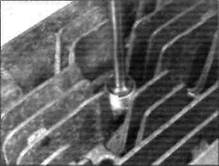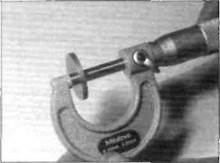
CATEGORIES:
BiologyChemistryConstructionCultureEcologyEconomyElectronicsFinanceGeographyHistoryInformaticsLawMathematicsMechanicsMedicineOtherPedagogyPhilosophyPhysicsPolicyPsychologySociologySportTourism
Cush drive rubbers dampen out transmission shocks
D
Degree discCalibrated disc for measuring
piston position. Expressed in degrees.
Dial gaugeClock-type gauge with adapters for
measuring runout and piston position. Expressed
in mm or inches.
DiaphragmThe rubber membrane in a master
cylinder or carburettor which seals the upper
chamber.
Diaphragm springA single sprung plate often
used in clutches.
Direct current (dc)Current produced by a dc
generator.
ref.50 Technical Terms Explained
Decarbonisation The process of removing
carbon deposits - typically from the combustion
chamber, valves and exhaust port/system.
DetonationDestructive and damaging
explosion of fuel/air mixture in combustion chamber instead of controlled burning. DiodeAn electrical valve which only allows current to flow in one direction. Commonly used in rectifiers and starter interlock systems. Disc valve (or rotary valve)A induction system used on some two-stroke engines. Double-overhead camshaft (DOHC)An engine that uses two overhead camshafts, one for the intake valves and one for the exhaust valves. DrivebeltA toothed belt used to transmit drive to the rear wheel on some motorcycles. A drivebelt has also been used to drive the camshafts. Drivebelts are usually made of Kevlar. DriveshaftAny shaft used to transmit motion. Commonly used when referring to the final driveshaft on shaft drive motorcycles.
E
Earth returnThe return path of an electrical circuit, utilising the motorcycle's frame. ECU (Electronic Control Unit)A computer which controls (for instance) an ignition system, or an anti-lock braking system. EGOExhaust Gas Oxygen sensor. Sometimes called a Lambda sensor. ElectrolyteThe fluid in a lead-acid battery. EMS (Engine Management System) Acomputer controlled system which manages the fuel injection and the ignition systems in an integrated fashion.
EndfloatThe amount of lengthways movement between two parts. As applied to a crankshaft, the distance that the crankshaft can move side-to-side in the crankcase. Endless chainA chain having no joining link. Common use for cam chains and final drive chains.
EP (Extreme Pressure)Oil type used in locations where high loads are applied, such as between gear teeth.
Evaporative emission control systemDescribes a charcoal filled canister which stores fuel vapours from the tank rather than allowing them to vent to the atmosphere. Usually only fitted to California models and referred to as an EVAP system.
Expansion chamberSection of two-stroke engine exhaust system so designed to improve engine efficiency and boost power.
F
Feeler blade or gaugeA thin strip or blade of
hardened steel, ground to an exact thickness,
used to check or measure clearances between
parts.
Final driveDescription of the drive from the
transmission to the rear wheel. Usually by chain
or shaft, but sometimes by belt.
Firing orderThe order in which the engine
cylinders fire, or deliver their power strokes,
beginning with the number one cylinder.
FloodingTerm used to describe a high fuel level
in the carburettor float chambers, leading to fuel
overflow. Also refers to excess fuel in the
combustion chamber due to incorrect starting
technique.
Free lengthThe no-load state of a component when measured. Clutch, valve and fork spring lengths are measured at rest, without any preload.
FreeplayThe amount of travel before any action takes place. The looseness in a linkage, or an assembly of parts, between the initial application of force and actual movement. For example, the distance the rear brake pedal moves before the rear brake is actuated.
Fuel injectionThe fuel/air mixture is metered electronically and directed into the engine intake ports (indirect injection) or into the cylinders (direct injection). Sensors supply information on engine speed and conditions. Fuel/air mixtureThe charge of fuel and air going into the engine. See Stoichiometric ratio. FuseAn electrical device which protects a circuit against accidental overload. The typical fuse contains a soft piece of metal which is calibrated to melt at a predetermined current flow (expressed as amps) and break the circuit.
G
GapThe distance the spark must travel in jumping from the centre electrode to the side electrode in a spark plug. Also refers to the distance between the ignition rotor and the pickup coil in an electronic ignition system. GasketAny thin, soft material - usually cork, cardboard, asbestos or soft metal - installed between two metal surfaces to ensure a good seal. For instance, the cylinder head gasket seals the joint between the block and the cylinder head.
GaugeAn instrument panel display used to monitor engine conditions. A gauge with a movable pointer on a dial or a fixed scale is an analogue gauge. A gauge with a numerical readout is called a digital gauge. Gear ratiosThe drive ratio of a pair of gears in a gearbox, calculated on their number of teeth. Glaze-bustingsee Honing GrindingProcess for renovating the valve face and valve seat contact area in the cylinder head. Gudgeon pinThe shaft which connects the connecting rod small-end with the piston. Often called a piston pin or wrist pin.
H

|
| Installing a Helicoil thread insert in a cylinder head |
Helical gearsGear teeth are slightly curved and produce less gear noise that straight-cut gears. Often used for primary drives.
HelicoilA thread insert repair system.
Commonly used as a repair for stripped spark
plug threads (see illustration).
HoningA process used to break down the glaze
on a cylinder bore (also called glaze-busting).
Can also be carried out to roughen a rebored
cylinder to aid ring bedding-in.
HT (High Tension)Description of the electrical
circuit from the secondary winding of the ignition
coil to the spark plug.
HydraulicA liquid filled system used to transmit
pressure from one component to another.
Common uses on motorcycles are brakes and
clutches.
HydrometerAn instrument for measuring the
specific gravity of a lead-acid battery.
HygroscopicWater absorbing. In motorcycle
applications, braking efficiency will be reduced if
DOT 3 or 4 hydraulic fluid absorbs water from the
air - care must be taken to keep new brake fluid
in tightly sealed containers.
I
Ibf ftPounds-force feet. An imperial unit of torque. Sometimes written as ft-lbs. Ibf inPound-force inch. An imperial unit of torque, applied to components where a very low torque is required. Sometimes written as in-lbs. ICAbbreviation for Integrated Circuit. Ignition advanceMeans of increasing the timing of the spark at higher engine speeds. Done by mechanical means (ATU) on early engines or electronically by the ignition control unit on later engines.
Ignition timingThe moment at which the spark plug fires, expressed in the number of crankshaft degrees before the piston reaches the top of its stroke, or in the number of millimetres before the piston reaches the top of its stroke. Infinity(~) Description of an open-circuit electrical state, where no continuity exists. Inverted forks(upside down forks)The sliders or lower legs are held in the yokes and the fork tubes or stanchions are connected to the wheel axle (spindle). Less unsprung weight and stiffer construction than conventional forks.
J
JASOQuality standard for 2-stroke oils. JouleThe unit of electrical energy. JournalThe bearing surface of a shaft.
K
KickstartMechanical means of turning the
engine over for starting purposes. Only usually
fitted to mopeds, small capacity motorcycles and
off-road motorcycles.
Kill switchHandebar-mounted switch for
emergency ignition cut-out. Cuts the ignition
circuit on all models, and additionally prevent
starter motor operation on others.
km Symbol for kilometre.
kmhAbbreviation for kilometres per hour.
L
Lambda (X) sensorA sensor fitted in the exhaust system to measure the exhaust gas oxygen content (excess air factor).
Technical Terms Explained ref-si
Lappingsee Grinding.
LCDAbbreviation for Liquid Crystal Display. LEDAbbreviation for Light Emitting Diode. LinerA steel cylinder liner inserted ina aluminium alloy cylinder block. LocknutA nut used to lock an adjustment nut, or other threaded component, in place. LockstopsThe lugs on the lower triple clamp (yoke) which abut those on the frame, preventing handlebar-to-fuel tank contact. Lockwasher A form of washer designed to prevent an attaching nut from working loose. LT Low TensionDescription of the electrical circuit from the power supply to the primary winding of the ignition coil.
M
Mainbearings The bearings between the
crankshaft and crankcase.
Maintenance-free (MF) batteryA sealed
battery which cannot be topped up,
ManometerMercury-filled calibrated tubes
used to measure intake tract vacuum. Used to
synchronise carburettors on multi-cylinder
engines.
MicrometerA precision measuring instrument
that measures component outside diameters
(see illustration).

Date: 2016-01-14; view: 989
| <== previous page | | | next page ==> |
| Angle-tightening cylinder head bolts | | | Tappet shims are measured with a micrometer |